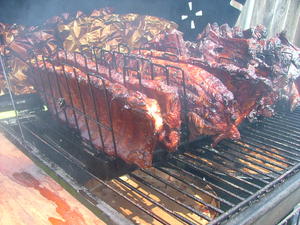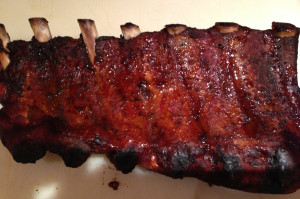 There are four primal tests to determine if your ribs are ready, but there are different tests for different ribs. Here’s an easy guide to know when it’s time to pull your ribs from the smoker.
There are four primal tests to determine if your ribs are ready, but there are different tests for different ribs. Here’s an easy guide to know when it’s time to pull your ribs from the smoker.
If you don’t have a smoker, you need to get one! Here’s our current Top Ten List of the Best Smokers, and an extensive review of our top choice, the Weber Smokey Mountain Smoker.
Spare Ribs
Spares are the traditional choice for sumptuous barbecued ribs, and come from the bottom section of the ribs of the pig, just above the belly. They are large in comparison to baby backs both in height and weight.
Temperature Check
Ribs are done at 180° F, and should be pulled somewhere between 180 and 190°F. As the meat doesn’t extend far from the bone, it can be hard to get an accurate internal temperature reading; the best method is using a thin probe from a good digital thermometer, like this Maverick Wireless Digital Thermometer .
Separation Test
This test is my choice, and all I use for spares. It’s foolproof and easy. With your tongs, grasp the rack about one third of the distance between the rib closest to you and the rib the furtherest away. Lift the entire rack away from the grill. If you see some cracking at the point where the tongs are grasping the ribs, they’re done. If not, they need a little more time.
Baby Back Ribs
Baby backs are from the top of the ribs, near….ready?……the back. They are smaller in all ways and require different testing methods.
It’s practically impossible to use a thermometer probe because of the smaller amount of meat. Using the tongs doesn’t work as well either, because they’re not as dense as the bigger spares.
The picture above is a half rack of baby backs. Notice how the meat has pulled away from the bone? That is a popular “how to tell if it’s done” test, and it’s not accurate so don’t use it. That separation can be caused by water evaporation and resulting shrinkage. The charred tips? Nope. Means nothing.
Manual Separation Test
This is similar to the separation test above using the tongs, but this test requires you to use your gloves and pick up the rack with both hands. Cup both hands around the ribs about six inches apart, and start to bend them down into an inverted “U” shape. If you can get them more than about 45 degrees without the rack cracking between the ribs, they’re not done. If they do crack, you’re probably good to go. See the next test.
Checking the Meat Color
If test one looks good, take a close look at the meat as ribs on the rack opens for you. You will probably see some pink on the first layer under the surface, but the rest of the meat should be white. It can be a little pink, but mostly white. If there’s any liquid, then they are definitely not done. Put ’em back and try again. If you see a lot of light brown meat, then you sure enough have your fall off the bone ribs, desired on not. Pull ’em; they’re (over)done.
Any other tests are anywhere from bogus to unreliable. Don’t worry too much about the actual temp if the ribs pass these simple tests. You’re safe at a 145 degree internal temperature, but you’ll want your ribs much more done than that. Your risks of bacterial contamination and contracting a nasty case of food poisoning are much greater with poultry than with pork.
Fall Off The Bone Ribs! Are You Sure?
That’s an unfortunate expression, because you can be guaranteed that any meat “falling off the bone” will not win any awards at a competition.
Having “fall off the bone” ribs is perfectly fine if that’s what you prefer, but honestly there’s a better end product. It’s hard to test without sampling, but the meat should easily tear from the bone after you sink in your teeth and gently pull the bone away from you. That’s the way a good, perfectly done rib should act.
Closely Related Cooking Guides For Perfect Ribs
Preparation of your ribs is extremely important, and we cover that from buying the best ribs forward here.
We’ve updated that article (there’s a link in it) recently, and go through the 3-2-1 method for spares, and the 2-2-1 method for baby backs, step by step. Seriously, you cannot go wrong with this method!
Got a Weber grill and no smoker? No problem! Here’s how to cook world class baby backs on any charcoal grill. I liked them better than the ribs I do on my custom cordwood fired pit.


Thank Tom! So glad the recipe worked out for you.
My first time with a smoked corned beef brisket. Had one in the freezer that I needed to use. Great info. Thanks, Dude.